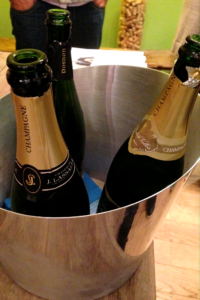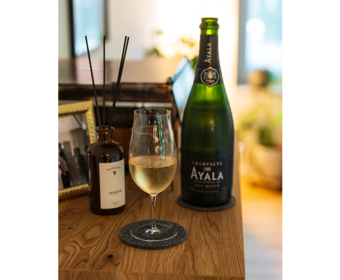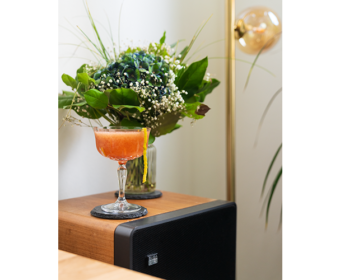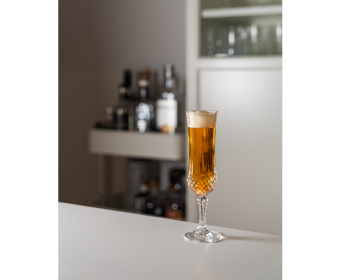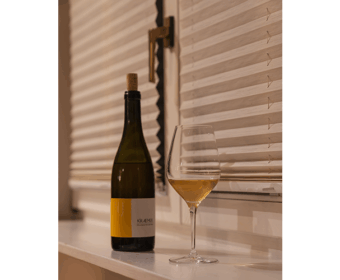Which Champagne Character Are You? – “Weininseln” in Munich
The advantage of moving to a bigger city is that there are more opportunities on what to do! This applies for almost any hobby, but in my case it should come as no surprise, that I am talking about something to drink. This time it is all about wine, since I had the chance to visit the “Wineinseln” in Munich! Also I had the opportunity to find out which champagne character I am.
Some time ago, I got to know Nicola Neumann through mutual acquaintances. Nicola is also from Nuremberg and she is one of the most experienced experts on champagne and wine I know. Apart from that, she also organizes wine tasting events all over Germany which are called “Weininseln”. There you have the chance to visit different wine bars and shops, which offer small tasting flights for a small service charge. Unfortunately, I had to work on Friday when the first “Weininseln” event this year took place. So, I only did manage to visit two locations. Nevertheless, it was still worth it!
Refined and elegant or strong and hands-on?
Of course, my first stop was at Nicola’s own shop Champagne Characters. There you could sample three different glasses of champagne. Each one had its own style and in the course of the tasting you were able to find out which character you are, depending on which own you prefered. The small tasting began with a light and easy drinking Cuvée. It continued with a more elegant Blanc de Blancs and the last glass was a polarizing and unusual 100 % Pinot Noir, Blanc de Noirs. But let us start at the beginning:
| J. Lassalle Cru Préférence 1er Cru | |
| Alcohol: | 12 % |
| Price: | 37 € per litre |
| Dosage: | 8 g |
| Grapes: | 60 % Pinot Meunier, 20 % Chardonay, 20 % Pinot Noir |
| Appearance: | crème, steady and noticeable perlage |
| Nose: | Apples, slight hint of yeast, acacia honey |
| Taste: | Honey, green apples, whiff of apricots, granny smith apples, noticeable acidity |
| Aftertaste: | Fresh and sour aftertaste with pip fruit aroma |
| Rating: |
The first of the three different champagnes was the perfect way to start the tasting. The J. Lassalle was very refreshing experience with a slim body and clear fruit aroma, accompanied by a noticeable acidity. I reckon this one would make the perfect Aperitif before a light summer dinner or to cool your nerves on a hot summer evening. Next came a totally different style of champagne. With the Blanc de Blancs from Diebolt-Vallois made out of 100 % Chardonnay grapes from Cuis, Chouilly, Epernay and young grapes from Cramant, the fresh notes were replaced by more mature yeast flavours.
| Diebolt-Vallois Blanc De Blancs | |
| Alcohol: | 12 % |
| Price: | 40 € per litre |
| Dosage: | 6 – 8 g |
| Grapes: | 100 % Chardonay |
| Appearance: | Straw, smaller and slightly less perlage |
| Nose: | Yeast, forest honey, pine needles |
| Taste: | Forest honey, yeast, brioche, almonds, boskop apples |
| Aftertaste: | Long aftertaste with baked goods aroma |
| Rating: |
Since, I am a fan of champagne which had the chance to develop some maturity, I enjoyed this one slightly more than the first. Still, with its dominating brioche notes and a dialled back acidity, it also was a little bit less interesting. From what I gathered from the other guests this one somehow was the crowd pleaser of the evening. Especially women seemed to like the combination of less acidity and honey pastry aroma. The third glass again managed to be completely different from the other two. If you take the grape variety into account this was less surprising. The Dosnon Récolte Noir is made out of 100 % Pinot Noir grapes, but the skins are immediately removed after the pressing of the grapes. This way the wine manages to stay white even if it is made from red grapes. Apart from that, fermentation and maturation both take place in Barrique barrels.
| Dosnon Récolte Noir | |
| Alcohol: | 12,5 % |
| Price: | 40 € per litre |
| Dosage: | 6 – 8 g |
| Grapes: | 100 % Pinot Noir |
| Appearance: | Light onion skin, small and elegant perlage |
| Nose: | Lactate, raspberries, flint stones |
| Taste: | Raw honey, flint stones, slight acidity, gooseberries |
| Aftertaste: | Long aftertaste with green apples and minerals |
| Rating: |
I almost expected the Dosnon Récolte to be my favourite, because it also was one of my favourites at the Champagne Tasting in Berlin. Moreover, I bought a bottle for last years Christmas dinner, too. If the Diebolt-Vallois is the right champagne for the ladies, the Récolte Noir is for the gentlemen out there! It is not an easy drinking champagne, but instead it is unbelievably complex and also the right wine to teach someone what Terroir is. It just has such a mineral taste that you are instantly taken back to tasting pebbles as a child. The Dosnon is not for the faint hearted champagne connoisseur, but for the strong and hands-on type of guys (and girls)!
On vertical and horizontal German wine

As I already told you, I only managed to visit two stops at the “Weininseln” and after Champagne Characters my second one was at Kork Die Weinbar. The owners Marion and Oliver Bruckner offered two different tasting flights of German wine: The first one consisted of three different German Riesling vintages from St. Anthony and the second one out were different German red wines. The interesting thing here was, that with the Riesling you were able to taste the same wine at different stages of maturation, whereas with the red wines you were able to try a variety of German reds. Naturally, the tasting of the St. Anthony Orbel Großes Gewächs began with the youngest e.g. the 2013 vintage and continued with the 2012 and 2011 vintages.
| St. Anthony Nierstein Orbel Riesling 2013 | |
| Alcohol: | 13 % |
| Price: | ~22 € per litre |
| Residual Sweetness: | 6,7 g per litre |
| Grapes: | 100 % Riesling, planted 1990 and 1993 |
| Appearance: | Light straw |
| Nose: | Honey, green apples, raisins |
| Taste: | Golden raisins, slight sweetness, fruity, mineral taste, green apples, dried plums |
| Aftertaste: | Long aftertaste with a great mix of acidity and sweetness |
| Rating: |
The youngest of the three different Riesling bottlings hit the spot right away! Although Großes Gewächse need to be dry, this one showed a slight sweetness which reminded me of off-dry Riesling from Germany’s Mosel region. Still, there was a noticeable acidity and a lot of minerals in the sip, which added to its complexity. I would have suspected the older vintages to have a dialled back sweetness and a little more mature, let’s call them Rancio, notes…
| St. Anthony Nierstein Orbel Riesling 2012 | |
| Alcohol: | 13,5 % |
| Price: | 21 € per litre |
| Residual Sweetness: | 2,7 g per litre |
| Grapes: | 100 % Riesling, planted 1990 and 1993 |
| Appearance: | Bright yellow |
| Nose: | Slight apple notes, whiff of chamomile, hints of dry straw |
| Taste: | Dominant green apple notes, reminiscent of dried fruits, some lactate notes |
| Aftertaste: | Medium long with green fruits and an apparent acidity |
| Rating: |
Well, what can I say? Yes, indeed there was less sweetness and also a more prominent acidity. However, the anticipated mature flavours were almost missing completely. All in all, the wine seemed a bit closed off. Still, with less sweetness it would be better suited as an Aperitif than the 2013 Orbel. With this drastic difference I was very curious to see what the 2011 vintage would be like.
| St. Anthony Nierstein Orbel Riesling 2011 | |
| Alcohol: | 13,5 % |
| Price: | 21 € per litre |
| Residual Sweetness: | 2,7 g per litre |
| Grapes: | 100 % Riesling, about 25 year old vines |
| Appearance: | Pastel gold |
| Nose: | Dried fruits, raisins, slight apple notes |
| Taste: | Some Rancio and golden raisin notes, clear acidity, honey, minerals, chalk, sage |
| Aftertaste: | Long with green apples and some dried fruits |
| Rating: |
The last one of the Orbels again managed to satisfy. It had clearly more complexity than the 2012 vintage, with hints of raisins and herbs. There also was a striking mineral taste. Still, when it comes to pure drinking pleasure it could just not live up to the first glass of Orbel. Unfortunately, the whole vintage seems to be sold off, otherwise I would have bought a few bottles to pair with my famous Thai curry.
Yet, Marion and Oliver also had a second flight with German red wine in stall, but because I did not have the time to get a proper dinner before hand, I had to limit myself to the most complex of the bunch. So I will quickly add my tasting notes here, although you might not get much out of them.
| Gies-Dueppel Quarz Spätburgunder 2013 | |
| Alcohol: | 13,5 % |
| Price: | 14 € per litre |
| Residual Sweetness: | 0,3 g per litre |
| Grapes: | 100 % Pinot Noir, 30 year old vines |
| Appearance: | Crimson |
| Nose: | Raspberries, vanilla, fruity, spices |
| Taste: | Red fruits, distinct tannins, herbs, thyme, red berries |
| Aftertaste: | Long aftertaste with dark chocolate and vanilla notes |
| Rating: |
In conclusion, it was very interesting to sample different German high-quality wines. Especially, to get to know one wine very well over different vintages was a new experience or me. The last glass of red wine was more of a nightcap than a really tasting experience, but still I got to know an interesting vinery I did not know before. The last and perhaps most important thing to take away from this article is, that events such as the “Weininseln” are a great opportunity for wine lovers to get to know a lot of different wines in one evening. Sure, you could just visit a regular wine tasting, but I bet you will not find the same diversity! So in the end there is nothing left to say apart from a big thank you to Nicola for all of her hard work to make this possible!


